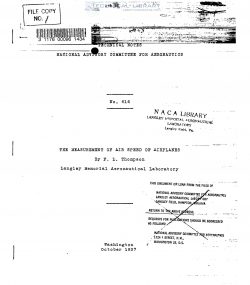naca-tn-616
- Version
- 63 Downloads
- 934.02 KB File Size
- 1 File Count
- November 25, 2016 Create Date
- November 25, 2016 Last Updated
National Advisory Committee for Aeronautics, Technical Notes - The Measurement of Air Speed of Airplanes

Various methods of measuring the air speed of air—
planes are described. Particular emphasis is placed on
the procedure required to obtain precise measurements of
Speed by the use of the suspended pitot- static head or
the suspended static head. Typical calibration curves
for service installations of pitot— —static heads are shown
and the relation between errors in air Speed and corre-
sponding errors in obs_erved altitude f_or such installa—
tions is discussed. There is included a brief discussion
of various speed—course methodsof measuring speed.
The measurement of the air speed of airplanes by
means of instruments attached to them is an almost univer—
sal practice, but the results of such measurements are
often very inaccurate, particularly with installations
used for normal flight. The sources of error are numerous
and not all of them are easily avoided. For special tests ’—
it is usual to resort to timed flight over a course be:
tween landmarks as a means of obtaining precise measure—
ments of speed. It is possible, however, to measure air
speed with a high degree of precision by means of instru—
ments attached to the airplane, and such a method is often
more convenient than that of the speed course. Thus the
instrument method, if the proper precautions are taken,
may be made to supplement or replace the speed-course method.
It is the primary purpose of this paper to discuss,
on the basis of experience gained in numerous flight tests
conducted at the laboratory of the N.A.C.A., the various
sources of error in the instrument method of measuring air
speed and to point out as well as possible how the errors
may be avoided The use of a pitot— ~static tube is assumed.
Consideration is given to two aspects of the problem: that
of measuring air speed with a high degree of precision for
special tests.wherein it is permissible to use special
test equipment; and that of measuring air speed with a
fair degree of precision for normal flying. The problem
of measuring air speed for normal flying includes consid—
eration of the provision of a satisfactory reference pres-
sure for the altimeter. In addition to the discussibn of
the instrument method of measuring air speed, there is al—
so included a brief description of various speed—course
methods.
| File | Action |
|---|---|
| naca-tn-616 The Measurement of Air Speed of Airplanes.pdf | Download |

Comment On This Post